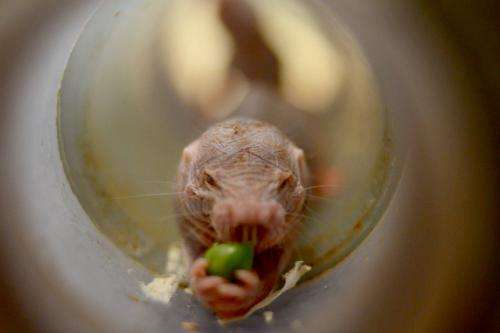Naked mole-rats may hold clues to pain relief

Naked mole-rats evolved to thrive in an acidic environment that other mammals, including humans, would find intolerable. Researchers at the University of Illinois at Chicago report new findings as to how these rodents have adapted to this environment.
The study was published online this week on PLOS ONE.
In the tightly crowded burrows of the African naked mole-rats' world, carbon dioxide builds up to levels that would be toxic for other mammals, and the air becomes highly acidic. These animals freely tolerate these unpleasant conditions, says Thomas Park, professor of biological sciences at UIC and principal investigator of the study—which may offer clues to relieving pain in other animals and humans.
Much of the lingering pain of an injury, for example, is caused by acidification of the injured tissue, Park said.
"Acidification is an unavoidable side-effect of injury," he said. "Studying an animal that feels no pain from an acidified environment should lead to new ways of alleviating pain in humans."
In the nose of a mammal, specialized nerve fibers are activated by acidic fumes, stimulating the trigeminal nucleus, a collection of nerves in the brainstem, which in turn elicits physiological and behavioral responses that protect the animal—it will secrete mucus and rub its nose, for example, and withdraw or avoid the acidic fumes.
The researchers placed naked mole-rats in a system of cages in which some areas contained air with acidic fumes. The animals were allowed to roam freely, and the time they spent in each area was tracked. Their behavior was compared to laboratory rats, mice, and a closely related mole-rat species that likes to live in comfy conditions, as experimental controls.
The naked mole-rats spent as much time exposing themselves to acidic fumes as they spent in fume-free areas, Park said. Each control species avoided the fumes.
The researchers were able to quantify the physiologic response to exposure to acidic fumes by measuring a protein, c-Fos, an indirect marker of nerve activity that is often expressed when nerve cells fire. In naked mole-rats, no such activity was found in the trigeminal nucleus when stimulated. In rats and mice, however, the trigeminal nucleus was highly activated.
The naked mole-rats' tolerance of acidic fumes is consistent with their adaptation to living underground in chronically acidic conditions, Park said.
Journal information: PLoS ONE
Provided by University of Illinois at Chicago
















